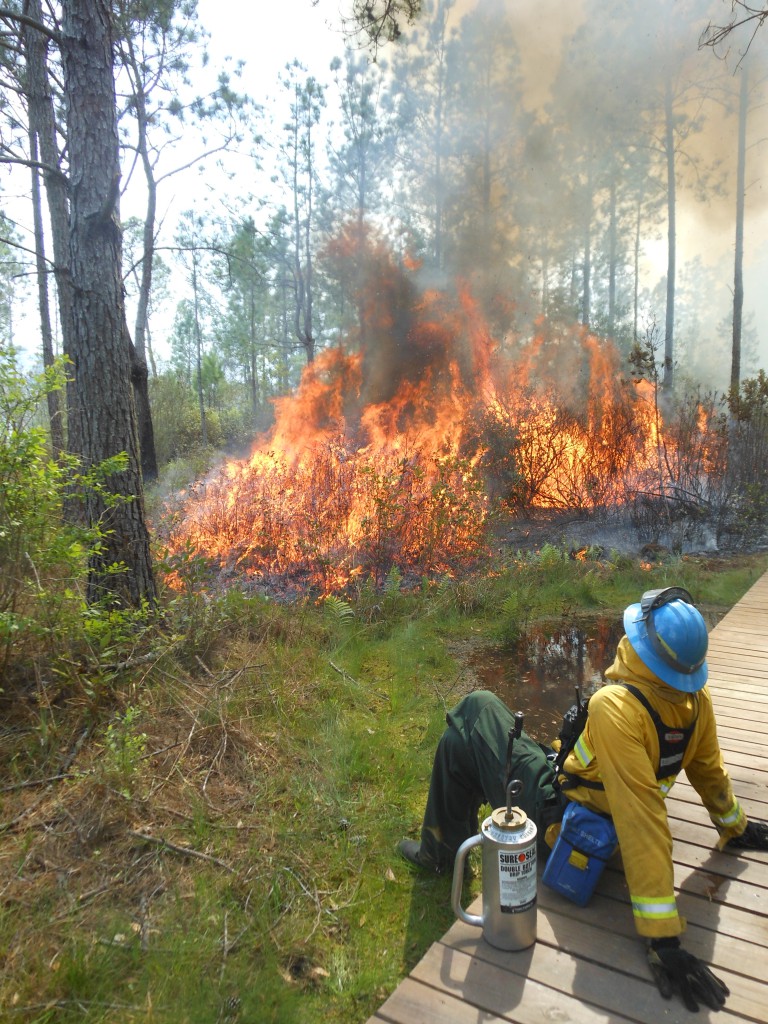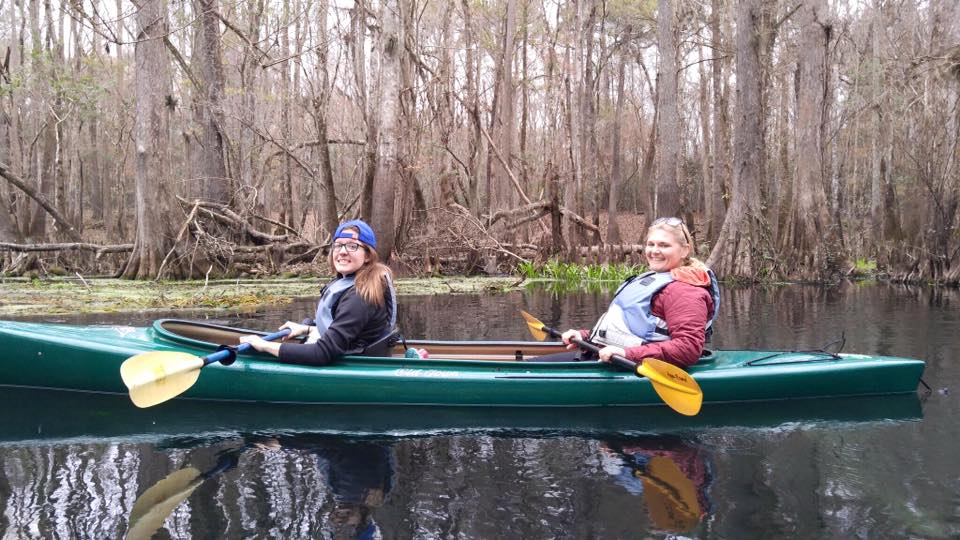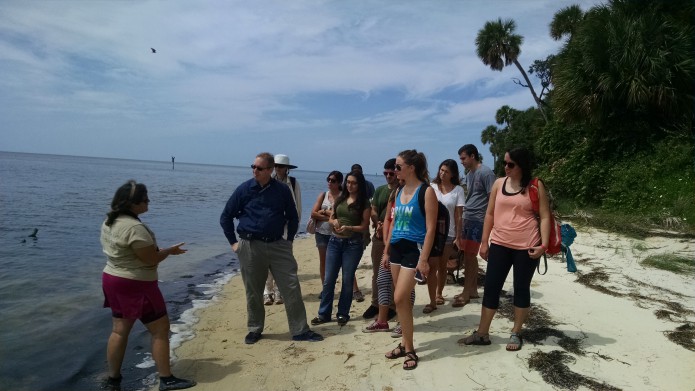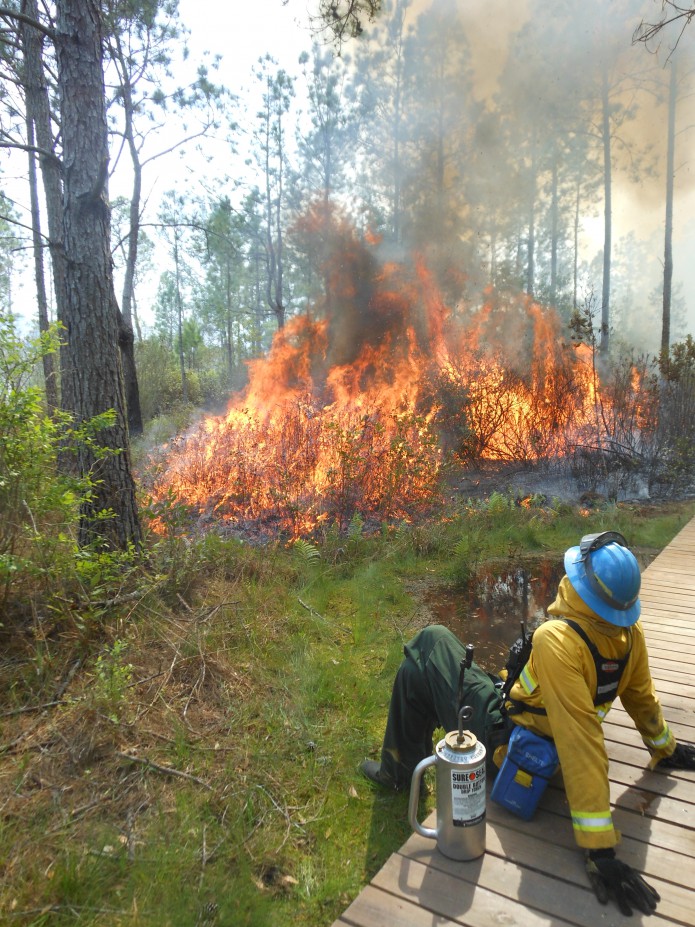
By Carley Reynolds
With ecosystems and societies around the world anticipating—or already facing—the consequences of climate change, the US Southeast may find an unlikely hero in a disappearing native tree: the longleaf pine.
These towering pine species once dominated the region as far north as Virginia and as far west as Texas. Now, only 3% of its historic range remains. Centuries of human development, timber production, and disturbance of their fire regime have drastically impacted the longleaf pine. But despite their past rapid decline, climate scientists and ecologists expect longleafs will emerge as some of the strongest survivors of a warming world – and some of the best-able to help communities cope with the effects of climate change. Longleaf pines are better adapted to handle more extreme precipitation patterns, severe storms, pest infestations, and fire than other southeastern species, according to a 2009 report from the National Wildlife Foundation.
One of the most remarkable features of longleaf pines is their habitat diversity. If you were to tell someone “Take me to see a longleaf pine,” you might find yourself in any multitude of different landscapes. Longleafs grow in widely varying environments—from Alabama mountainsides to wet flatwoods to dry sandhills.
Already adapted to a wide range of landscapes, longleaf pines are expected to hold up better against a future of prolonged and intensified droughts and floods.
Longleafs also have a considerable track record for surviving severe storms and hurricanes. After Katrina devastated the Gulf in 2005, researchers in Mississippi evaluated the damage, finding mostly healthy longleaf among the carnage of two other pines native to the slash and loblolly pines. Compared with robust longleaf, skinny but fast-growing slash and loblolly pines suffered. The researchers found that 64% of longleaf were unaffected while only 52% of slash and 16% of loblolly survived unscathed. Longleaf not only had less affected trees, but also less intense damage. Slash and loblollies often snapped mid-stem. The longleaf damage was little more than leaning. In terms of timber production, a snapped stem means a major loss in value.
Climate change is also expected to exacerbate damage from pests, particularly the southern pine beetle, which has already cost the United States hundreds of millions of dollars in economic . With warmer temperatures and changing precipitation patterns, the beetle’s range will most likely expand. Longleaf pines are significantly less susceptible to infestation than other species. Planting the more resilient species could lessen the extreme losses.
Maintaining Longleafs, Mitigating Carbon
This winter, the Florida Forest Service (FFS) broke a record. Over two days in January, a team of 60 foresters managed the largest controlled burn ever carried out at Goethe State Park — 12,345 acres. The massive park covers 53,587 acres itself and contains the largest contiguous tract of longleaf pine in Florida.
Prescribed burning is a management tool used to maintain forest health, promote biodiversity and reduce the risk of dangerous wildfires. Without fire, woody plants like laurel oaks move in and compete with the herbaceous plants like grasses native to these fire adapted ecosystems. “Frequent fire in effect mows down broadleaf woody plants,” says Kevin Robertson, fire ecology scientist at Tall Research Station. This allows more sunlight into the canopy and brings about a more diverse ecosystem.
Even considering these benefits, setting thousands of acres of forest on fire hardly seems like a sensible way to combat carbon emissions. Burning releases carbon stored in trees and other organic matter found in forests. But, counter-intuitive as it sounds, prescribed burning reduces emissions in the long run.
When forests go unburned for a long time, fuel accumulates. These conditions lead to higher-intensity, more-dangerous forest fires. Regular burning reduces the build-up of flammable materials and results in less-severe fires.
These milder fires creep through the understory, leaving some vegetation intact. High intensity wildfires scorch the landscape, often killing even the most fire-adapted species. Prescribed burning reduces the risk of these dangerous and destructive wildfires that spew out significantly more climate-warming carbon. A study from Northern Arizona University found that prescribed burning reduces carbon emissions 18 percent to 25 percent on average – and sometimes as much as 60 percent.
The longleafs themselves also store more carbon, far longer than their scrawnier counterparts. Through photosynthesis, plants take up carbon dioxide from the atmosphere and store it in until they die.
Longleafs outlive both slash and loblolly pines. Archaic stands of old-growth longleaf can have pines as old as 450 years, twice the lifespan of their young brothers. For the first 120 years, the trees take in and store more carbon than they release from natural mortality. After they die, longleafs also release carbon at a slower rate due to the higher quality of their wood.
Planting more longleaf pines would tie up more carbon, reducing greenhouse gases in the atmosphere.
Moving Forward: The Future of Longleafs
As the longleaf’s advantages have emerged, scientists and policymakers have launched significant efforts to protect and expand their forests. The Obama Administration’s America’s Great Outdoors initiative of 2010 created the Longleaf Stewardship Fund, bringing together funding from private and public groups to protect longleaf pines.
New carbon policies may serve as a welcome ally to restoration efforts as well.
Assembly Bill 32, the California Global Warming Solutions Act of 2006, was passed with the intention of reducing California’s greenhouse gas emissions to 1990 levels. One aspect of AB 32 allows companies to offset their emissions by investing in projects that reduce carbon in the atmosphere, including investing in southeastern pine plantations.
That could mean more longleafs. AB 32 requires forest and plantation used to offset carbon emissions to be diverse. Specifically, they can’t be comprised of more than 70% of a single species. Since either slash or loblolly pines generally dominate plantations, companies will have to include other species in their stands. “We’re hoping the other 30% will be longleaf,” says Robert Abernethy, president of the Alabama-based Longleaf Alliance.
While longleaf pines have immense potential to adapt to climate change, research continues to investigate the long-term fate of these southeastern icons. With conditions changing rapidly on a geologic time scale, species must either adapt to their new environments or migrate as their distribution range shifts—the more likely option. Unfortunately for trees, they can’t pick up and move all that easily.
Foresters with the Nature Conservancy have started experimenting with the “assisted migration” of longleafs. This means introducing the pines to potentially favorable regions. The researchers planted twenty acres of pine seedlings in Maryland, just north of their natural range. One year later, they conducted a prescribed burn, maintaining a healthy environment for the young seedlings. While the team dubbed the burn a success, conclusions on the future home of longleafs and the viability of assisted migration will take time.
Conserving and restoring longleaf isn’t only sensible as a climate change adaptation strategy, but also from economic and ecological perspectives.
The prolonged dormant grass stage of longleafs and difficulties with regeneration have lead timber producers to typically favor raising slash pine in the south and loblolly pine in the north. However, improvements in longleaf planting and growing techniques have made them a viable contender for the industry. For example, planting seedlings initially sowed in containers over bare-root seedlings has increased the success of establishment and can even reduce the time to initial growth. Longleaf stands also produce higher quality timber. The straight, durable trunks of longleaf can more often sell as pole timber, a highly valued wood product. Resilience to pest infestation and damage from storms also reduce risk of economic loss.
Investing in longleaf ecosystems would also bring relief to a rich community of animals and plants. Many threatened and endangered species rely on longleaf pine habitat such as the red cockaded woodpecker, the gopher tortoise, and the flatwoods salamander.
While climate change will undoubtedly stress ecosystems—including longleaf—the resilient pine is the contender to watch in a world that will be forced to adapt.






